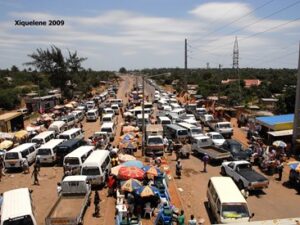The port city Maputo was never a vibrant cycling city—the result of colonial rather than current policies. In colonial times, only a few non-white residents like Indian Mozambicans used the bicycle for transport. In the 1930s, the colonial elites used cycle rickshaws, two or three wheeled passenger carts—pulled by black colonized Mozambicans (Changanas)—as public transport until the mid-1950s. Since then, the bicycle was used for either individual transport or sport. Most white colonial settlers commuted by car or public transport while most Africans walked to their daily activities.

Cycling’s relatively low status was reinforced by Maputo’s urban expansion. The old city has been expanding rapidly—an expansion that increases people’s commuter time without the policy of providing the necessary transport infrastructure, shaping what mobility options people have. The compact colonial city Maputo gained its city status only in 1880, but when it expanded along the Espírito Santo Bay (now Maputo Bay), it was ruled by spatial segregation of social and racial groups into European neighborhoods and African suburbs. The colonial administration built European neighborhoods with better roads and urban services facilities, which deteriorated the farther one went from this area. Only the few white settlers and some Indian and Chinese traders, who were better off and who could afford the expensive bicycle, cycled. Over time, most colonial settlers used cars, busses, and trains. Most Africans walked to get around or commute and few cycled. That changed radically during the civil war.
Mozambique’s civil war (1980-1994) after independence from Portugal in 1975 had a major impact on people’s mobility options. During the civil war, many Mozambicans from surrounding rural districts fled to Maputo City in search for safe place to live. Most refugees settled at the city’s periphery. The rapid population growth degraded the urban environment and worsened transport conditions: public transport authorities failed to make transport services accessible for most residents. Buses and trains were often unreliable forcing people to look for individual mobility alternatives. As a result, walking and cycling increased dramatically during the civil war.


The second period after the civil war (since 1995), Maputo rapidly expanded with better streets, public transit routes, formal jobs, and basic services in the city center, but the outlying areas were still underserved. The sprawling suburbanization dramatically increased in car ownership and traffic congestion. It rendered cycling impractical and unsafe. Maputo’s thriving cycling culture quickly collapsed to a share of modal split of just over 1% in 2014.

Today’s Maputo’s cycling culture is bifurcated and segregated. High-income people cycle for leisure and sport. Rural folks in rural Maputo cycle to commute out of necessity. The segregation is also reflected in the social movements that promote cycling. In rural areas, MOZAMBIKES provides more robust and appropriate bicycles for the challenges of these areas. In urban areas, other associations like Bicycles Betinho, Bike zone moz, Critical mass and many others, however, promote the use of sports bicycles for men as a lifestyle.
Dr. Classio João Mendiate and Eduardo Pelembe de Santos are leading the research in reconstructing Maputo’s complicated cycling history since 1910 to the present as part of Cycling Cities: The African Experience and made possible by The African Urban Mobilities: Past, Present and Future Network with support from the University of Witswatersrand, History Workshop, South Africa, University of College London Urban Laboratory; History Department, Bayero University, Nigeria, and Eindhoven University of Technology, TIS History Lab and SHT with support from VREF.